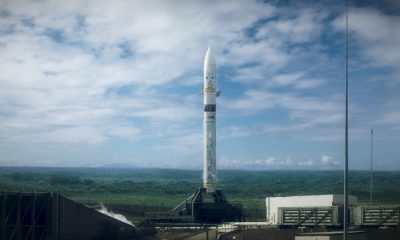Go ginearálta
Tá satailít nua Copernicus Sentinel-6A ríthábhachtach chun monatóireacht a dhéanamh ar ardú leibhéal na farraige domhanda

Rising seas are an urgent global concern. As the new reference altimetry mission, the Copernicus Sentinel-6A Michael Freilich satellite is key to monitoring global sea level rise, critical to helping mitigate the impacts of climate change and protect vulnerable communities. Launched 18 months ago, Sentinel-6A data is now being ingested into the Copernicus Marine catalogue and this will improve over half of the entire portfolio.
Since March 2022, the Copernicus Sentinel-6 has taken over from its predecessor Jason 3 as the reference altimeter mission, with which it had been flying in tandem. Sentinel-6A is optimized for ocean climate monitoring and it will provide the world’s most precise data on sea level. With this major step, Sentinel-6A will ensure the continuity of the 30-year record on mean seal level from satellite radar altimeters and will be used to cross-calibrate sea level and wave measurements from all other satellite altimetry missions worldwide.
The Copernicus Marine Service, implemented by Mercator Ocean International on behalf of the European Commission, has recently begun ingesting Sentinel-6A data into its catalogue, that will provide new and improved ocean datasets, some essential for marine safety, maritime navigation, and coastal zone management and in the creation of adapted ocean and climate policy.
Evolution in Copernicus Marine portfolio
The Copernicus Marine Service has nearly 450,000 users worldwide and provides ocean data across the Blue (physical), White (sea ice), and Green (biogeochemical) Ocean. Providing a substantial boost to our Blue Ocean portfolio, Sentinel-6A data is expected to improve up to 60% of Copernicus Marine’s observation and modelling products. Since April 6th, Sentinel-6A satellite observations on sea level and waves have been added to the catalogue and these comprise about half of the expected improvement, while the remaining will benefit the model products.
These will be followed by improvements to various models after a process of data assimilation in which observation data is injected into numerical forecast models, increasing their accuracy. Many of our global and regional physical and wave models will undergo these updates throughout April and May 2022. Pierre-Yves Le Traon, the scientific director at Mercator Ocean International (implementor of the Copernicus Marine service) commented: "The addition of Sentinel-6 data marks a major milestone in tracking sea level rise from global to coastal scales and improving over half of our catalogue, both with high accuracy sea level observations and by increasing the quality of our ocean forecasts through data assimilation”.
Satellite sea level products
Mercator Ocean International’s Scientific Director, Dr Pierre-Yves Le Traon, explained on the EUMETSAT blog how MOi incorporates Sentinel-6 data into models and products essential for marine safety, maritime transport, and coastal zone management as well as for informing ocean and climate policy.
“Sentinel-6 is key in being used to cross-calibrate all altimeter missions that we use. It’s also important to highlight the fact that Sentinel-6 consists of not only one but two satellites —Sentinel-6A and -6B—so we will have the insurance of the long-term continuity of this reference mission for a long time, until at least 2030. This is quite an achievement,” said Le Traon.
EUMETSAT operates the Sentinel-6A data delivery, and the Copernicus Marine Service depends on this service to then build products at a higher processing level through our Sea Level Thematic Assembly Centre (SL TAC). The data processing and dissemination of processing Level-1 (L1) to Level-2 (L2) Sentinel-6A sea level products is performed at EUMETSAT, it is also for responsible global Level-3 (L3) data processing.
The Copernicus Marine’s SL TAC, led by CLS, will perform the regional L3 and L4 data processing and the dissemination of L3-L4 sea level products will be centralised within the Copernicus Marine central dissemination unit. There are currently many satellite altimeters flying that are used by our service to track sea level and now Sentinel-6A will be the reference used to calibrate this data across a handful of satellites. Marie Isabelle Pujol of CLS and service manager or the Copernicus SL TAC commented:
“The integration of Sentinel-6A into the SL-TAC system is an important step. Sentinel-6A is now the new reference mission in our system. This means that the sea surface height (SSH) measured by Sentinel-6A is used as a reference to calibrate the SSH measured by the other altimeters, at the global but also regional scale. Sentinel-6A will therefore guarantee the continuity of the measurement of the mean sea level in the next years. Moreover, the SAR mode available on Sentinel-6A allows us to reduce the measurement noise and thus to improve the quality of the products and to increase the resolution of these products for the observation of the signal at smaller scales”.
The figure below shows the evolution of the daily mean sea level anomaly captured for different missions. It underlines how Sentinel-6A ensures the continuity of the mean sea level measurement. There is no discontinuity observed at the transition between Jason-3 (the previous reference mission) and Sentinel-6A and there is good consistency across the different missions.
naisc Úsáideacha
- Copernicus Marine Fógra Úsáideora on Sentinel-6A sea level and wave data release
- EUMETSAT Blog: Sentinel-6 reveals clues about the climate hidden in the ocean
- Jason-3 hands over Reference Altimetry Mission to Sentinel-6
- New Copernicus Satellite: How Sentinel-6 will Improve Ocean Monitoring
- Extending the legacy of sea level measurements until at least 2030 with Sentinel-6 M. Freilich
Maidir le Seirbhís Mara Copernicus
The Copernicus Marine Service is dedicated to ocean observation, monitoring and forecasting. It is funded by the European Commission (EC) and implemented by Mercator Ocean international (MOi), a centre for global ocean analysis and forecasting. The MOi scientific experts design, develop, operate and maintain state-of-the-art numerical modelling systems that describe and analyse the past, present, and near-future state of the ocean in 4D (reanalyses, hindcasts, near-real time analyses and forecasts).
Copernicus Marine provides regular and systematic reference information on the state of the physical and biogeochemical ocean at the global and European regional scale. It provides key inputs that support major EU and international policies and initiatives and can contribute to: combating pollution, marine protection, maritime safety and routing, sustainable use of ocean resources, developing marine energy resources, blue growth, climate monitoring, weather forecasting, and more. It also aims to increase awareness amongst the general public by providing European and global citizens with information about ocean-related issues.
Maidir le Mercator
Mercator Ocean International (MOi) was selected by the European Commission (EC) to implement the Copernicus Marine Service in 2014. Based in France, it is a is in the process of becoming an intergovernmental organisation providing world-class operational oceanographic expertise and services (implementor of the Copernicus Marine Service) as well as carries out Earth Observation and knowledge-sharing initiatives. It has also been selected by the EC as one of three implementers of the Copernicus WEkEO DIAS cloud platform that provides the Copernicus programme data alongside high-powered computing resources. MOi has a strong stake in supporting international ocean governance and thus engages in Blue Diplomacy through a variety of missions. MOi is also entrusted by the European Commission to bring an enhanced and fit-for-purpose global ocean observing system by implementing the European coordination of GEO's Blue Planet Initiative and G7 Future of the Seas and Oceans Initiative under the framework of EU4OceanObs.
The Copernicus Marine Service website
The website of Mercator Ocean International
Tá breis eolais faoin clár Copernicus
Comhroinn an t-alt seo:
-

 TobacLá ó shin 5
TobacLá ó shin 5Cén fáth nach bhfuil beartas an AE maidir le rialú tobac ag obair
-

 chasacstáinLá ó shin 4
chasacstáinLá ó shin 4Turas na Casacstáine ó Fhaighteoir Cúnaimh go Deontóir: Mar a chuireann Cúnamh Forbartha na Casacstáine leis an tSlándáil Réigiúnach
-

 An Mean OirthearLá ó shin 5
An Mean OirthearLá ó shin 5Tagann freagairt an AE ar stailc diúracán Iosrael ar an Iaráin le rabhadh ar Gaza
-

 chasacstáinLá ó shin 4
chasacstáinLá ó shin 4Tuarascáil Chasacstáin ar íospartaigh an fhoréigin























